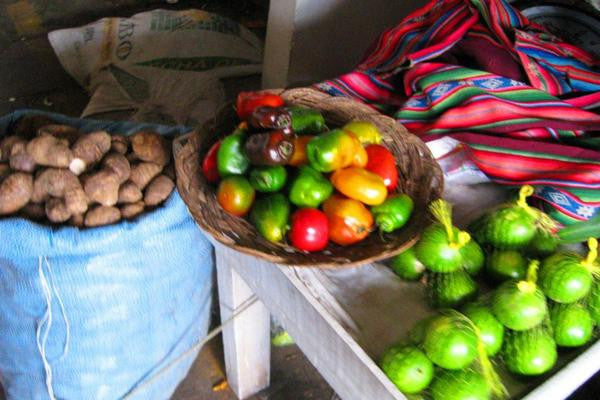INTERNATIONAL EATING, EAT IT ALL WITHOUT GETTING SICK
June 16, 2016

In our opinion, travel is the best way to gain new experiences. We fly across the globe to see and do new things. So of course, it would makes sense to eat new things too. When I say we have a lot of experience in international eating, I mean it. We'll cover tips for international noshing sans stomach upset, some of the most interesting bites we've ever had, and some stories that will let you learn from our mistakes. Enter cheesy food pun here: bon appétit!

1. Eat it like it's hot.
So we've landed in Cusco, Peru and gotten somewhat settled. First official order of business is to find something to eat. We flipped through our guide book to see if there were any customary edibles. Sure, we could go for some culturally relevant spit roasted guinea pig... Though, it doesn't appear as though the locals are dining on small rodents on the day to day. So, we dive into the street market across the way.
The smells are amazing, we eye up a small vendor with a grill full of chicken and golden potatoes and know we're in the right place. Here's the most important eating tip we can offer... always make sure that street food comes immediately off the heat source. In this case, the vendor was grilling meats until thoroughly cooked. We eyed a skewer that had been cooking for a long time and pointed to it. The goal is make sure the food is hot, not just reheated briefly, but just cooked. We have eaten some pretty wonderful street food, hot and ready is the trick to reducing the chance of catching a bug. Hot and ready, that's the trick!

2. Eat what the locals are eating.
I touched on this a little bit. Every country has a historical, native cuisine. It's fun to partake in some throwback foods (Fried tarantula anybody?). If you really want to get into to the local groove, take a look at what the locals are eating. Find a restaurant that is off the tourist path a little bit or hit a local market. Find somebody eating something that looks appetizing (or not?) and ask for the same thing. This is especially useful in Asian countries where even a little Latin skill can't discern the variety of food you might be ordering off the menu. In Costa Rica, we lived off fresh pineapple and dined on rice and beans for breakfast. To experience a place, it's important to eat something authentic, but also eat something current and relevant.

3. Bring on the bubbles.
Many countries, especially less developed, will refer to sealed water bottles as the 'tourist bottle'. Make sure the water bottle seal is still in tact. To avoid confusion on tap versus sealed water at restaurants, a safe bet is carbonated or other bubbly beverages. Pretty much everywhere we have been outside the USA has referred to carbonated water as 'water with gas' and it's good for a few immature giggles to request while seated for a fancy meal. Another tried and true method? Drink beer.
4. Pick it packaged.
Packaged goods are generally safer than non-packaged. This is especially true of cookies and baked goods. If you want to go fresh with baked goods, we don't blame you. I ate many a baguette in France from small stone oven bakeries in the hills, and it's worth it! In this case, go with baked goods that are prepared on location. Better yet, wait on the next batch coming out of the oven and rest assured it hasn't had any time to collect anything that could upset your system.

5. Craving something fresh? Go for fruits and vegetables with peels.
Fruits and vegetables sold here in the US are often chemically washed or come from farms that adhere to strict US standards of pesticide application. Lucky us, right? When travelling, it is fun to eat exotic fruits and vegetables. Though, it is best to be careful in this territory. The safest bet is fruits with peels that are discarded, like oranges or bananas. The next best option is to wash your produce thoroughly with bottled or treated water. A quick rinse in the faucet will not guarantee that apple is any cleaner in, say, China. Also to keep in mind, produce sold here in the US is selected for its aesthetic qualities. We are accustomed to very handsome fruits, but don't fear the ugly! The best tomato I have ever tasted was not winning any beauty contests. You might notice these uglier fruity relatives are more flavorful and sweet than than the commodity veggies we dine on for dinner on the daily.

Salads can be a bit risky in some countries, as the leaves might be washed in contaminated water or not rinsed at all. To get your share of greens, go cooked or blanched. Boiled corn with giant kernels is sold on the streets in Peru (right from the hot water, remember?) and boiling soups full of lemongrass and herbs won't disappoint in Thailand. Most cuisines have a soup or cooked vegetable dish that locals like to dine on, even when the temperatures outdoors are steamy.

6. Cook it yourself.
When in Rome, why not cook like a Roman? Another great way to experience a local cuisine is to head to the local markets and make yourself dinner. Instead of the typical hostel or hotel, we rented an Airbnb in Florence and cooked several memorable meals. This is also a great way to keep a tight budget. You can also try your hand at a local cooking class, and take the new skill home with you to share with family and friends. If your not quite up the the cooking challenge, try some local tea or condiment that you can bring back with you and share.


7. A word on ice.
Say you're in Mexico... the day has been hot and you've earned yourself an obligatory Margarita. Make sure the bar you are at uses ice from filtered water (resorts that cater to westerners usually do). When in Peru, we went out one evening and had some excellent cocktails only to realize that the ice was not filtered. It's easy to overlook ice, even when being hyper vigilant. When having popular fresh fruit smoothies in South America, watch the preparation and ask for just fruit, no ice or yogurt.

8. The ice cream man is out to get you.
On several occasions while travelling, we have seen locals pushing ice cream carts. They are always present when you are feeling weakness. It's hot, the van on the way to the rafting drip got a blowout, and you would do just about anything for a cone. Street ice cream is often not a good idea, there's no knowing how many times it has been thawed and refrozen. Eat yourself full on gelato in Italy, but steer clear of the push cart selling frozen goodies.
9. When you get sick anyways.
In Cambodia, we had just finished a cross country dirtbike trip to make it to the southern coast. We heard there were undeveloped oceanic islands off the coast that can rival nearby Thailand's exploited offerings. We boarded a small boat out of Sihanoukville to a tiny exotic island to spend the night and next day recovering from our journey.

Upon getting to the island, Chris started feeling a bit under the weather. We shook it off, until later that evening we were dealing with a raging fever and the onset of delirium. The tropical temperature where we camped only made the problem worse, and there were not escape boats or cell service to reach help. With only 3 tablets of ibuprofen and a dying phone battery, we made it through the night 30 minutes at a time. I soaked everything in cool water, even the bedding, in hopes of hanging on just a few more hours.
As soon as the sun came up, we managed to get on a boat to leave the island. Chris was much more coherent by the time we landed back on the mainland. We hired a tuk tuk to take us to a nearby hospital. By the time we arrived at the hospital, we were still dealing with a 106 degree fever... which we can only imagine is lower than what we were managing the night before. A few tests and some antibiotic shots later, we are confident that the source of the sickness was some packaged cookies we ate on the motorcycle trip from the north.
Of all the nutso things I probably wouldn't do again in my life, that night on the island was by far the most frightening. We did a few things right and few things wrong. Sadly, the packaged cookies turned out to be a bad choice- there is always risk when eating abroad. We should have packed enough fever reducer for a full dosage for at least 16 hours so that we could make it through a night. We also should have avoided going so far off the grid without feeling entirely healthy- but it's easy to overlook mild discomfort when you are excited.

One thing we did right was travel with a guidebook. We carried the Lonely Planet guide to Cambodia and it has a section of hospitals in the back. The hospitals have been visited by the writers, who are usually westerners. The care we got at the hospital in Cambodia was excellent, and the physician spoke english enough to converse. The total bill, all tests, treatments, and prescriptions, totaled $100USD.
Both feeling ill and suffering from food poisoning, we spent the remaining days in Cambodia recovering at a hotel before flying back to the US. We navigated the airports cautiously, avoiding fever scanners and never straying too far from a bathroom.
Sometimes getting sick is unavoidable. Make sure you have a fully stocked kit with fever reducer, anti-diarrheals, and some electrolyte powder to add to water. Antihistamines and a run of antibiotics are an excellent addition. Before leaving the US, look up local hospitals or bring a guide book with this information in it. Some travel insurance can cover medical costs overseas. We have also found that care abroad is substantially less expensive than care locally, so don't be afraid to seek medical attention if you need it.
Eating abroad is great fun and a fantastic way to experience the local culture. Go head, get out there and eat.


0 comments